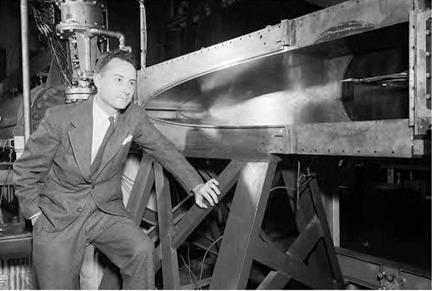The Cold War and the Space Age
In 1958, NASA was on a firm foundation for hypersonic and space research. Throughout the 1950s, NACA researchers first addressed the challenge of atmospheric reentry with their work on intercontinental ballistic missiles (ICBMs) for the military. The same fundamental design problems existed for ICBMs, spacecraft, interplanetary probes, and hypersonic aircraft. Each of the NASA Centers specialized in a specific aspect of hypersonic and hypervelocity research that resulted from their heritage as NACA laboratories. Langley’s emphasis was in the creation of facilities applicable to hypersonic cruise aircraft and reentry vehicles—including winged reentry. Ames explored the extreme temperatures and the design shapes that could withstand them as vehicles
|
John Becker with his 11-Inch Hypersonic Tunnel of 1947. NASA. |
returned to Earth from space. Researchers at Lewis focused on propulsion systems for these new craft. With the impetus of the space race, each Center worked with a growing collection of hypersonic and hypervelocity wind tunnels that ranged from conventional aerodynamic facilities to radically different configurations such as shock tubes, arc-jets, and new tunnels designed for the evaluation of aerodynamic heating on spacecraft structures.[581]











